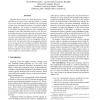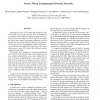5 search results - page 1 / 1 » Detecting Intra-enterprise Scanning Worms based on Address R... |
ACSAC
2005
IEEE
14 years 17 days ago
2005
IEEE
Signature-based schemes for detecting Internet worms often fail on zero-day worms, and their ability to rapidly react to new threats is typically limited by the requirement of som...
CCS
2003
ACM
14 years 5 days ago
2003
ACM
After the Code Red incident in 2001 and the SQL Slammer in January 2003, it is clear that a simple self-propagating worm can quickly spread across the Internet, infects most vulne...
DSN
2009
IEEE
14 years 1 months ago
2009
IEEE
Topological worms, such as those that propagate by following links in an overlay network, have the potential to spread faster than traditional random scanning worms because they h...
IMC
2004
ACM
14 years 11 days ago
2004
ACM
Monitoring any portion of the Internet address space reveals incessant activity. This holds even when monitoring traffic sent to unused addresses, which we term “background rad...
ASPDAC
2004
ACM
14 years 11 days ago
2004
ACM
— We have developed the first real-time 3-D image sensor with VGA pixel resolution using mixed-signal techniques to achieve high-speed and high-accuracy range calculation based ...


